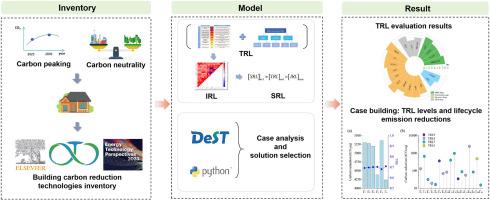Optimizing carbon reduction technologies portfolios of buildings: Lifecycle approach based individual and system technology readiness level assessments
IF 9.4
1区 工程技术
Q1 ENERGY & FUELS
引用次数: 0
Abstract
The building sector contributes significantly to global carbon emissions. Despite the development of various carbon reduction technologies (CRTs), challenges persist in assessing their maturity and effectively selecting technology combinations for emissions reduction. To address this issue, this study constructed a list of building CRTs covering 19 technologies for a Chinese case building, and established a quantitative assessment method for the Technology Readiness Level (TRL) rating of building CRTs. Furthermore, This study developed a System Readiness Level (SRL) evaluation model based on TRL and Integration Readiness Level (IRL), and proposed an optimization model for carbon reduction technology combinations using SRL as a key constraint. The NSGA-III algorithm was utilized to solve for the optimal technology combination of the case study building, aiming to maximize building carbon reduction while satisfying constraints on technology combinations and system maturity. The results show that the SRL of the optimal carbon reduction scheme for the case building is 0.701, in which the CRTs of high level TRL account for more than 54 % of the technology combination, indicating that the scheme has high reliability and operability in practical engineering applications. Meanwhile, the carbon reduction rate of the program reaches 93.91 %, of which the carbon reduction contribution of renewable energy technologies is as high as 47.01 %. The proposed methodology provides a robust framework for selecting scalable and effective CRT portfolios, contributing to whole-life-cycle carbon reduction in buildings.

优化建筑的碳减排技术组合:基于个人和系统技术准备水平评估的生命周期方法
建筑行业对全球碳排放的贡献很大。尽管各种碳减排技术(crt)得到了发展,但在评估其成熟度和有效选择减排技术组合方面仍然存在挑战。为解决这一问题,本研究构建了中国案例建筑的19种技术的建筑crt清单,并建立了建筑crt技术成熟度(TRL)评级的定量评估方法。在此基础上,建立了基于TRL和集成准备水平(IRL)的系统准备水平(SRL)评价模型,并提出了以系统准备水平为关键约束的碳减排技术组合优化模型。利用NSGA-III算法求解案例建筑的最优技术组合,在满足技术组合约束和系统成熟度约束的前提下,实现建筑碳减排最大化。结果表明,案例建筑最优减碳方案的SRL为0.701,其中高水平TRL的crt占技术组合的54%以上,表明该方案在实际工程应用中具有较高的可靠性和可操作性。同时,项目碳减排率达到93.91%,其中可再生能源技术的碳减排贡献高达47.01%。所提出的方法为选择可扩展和有效的CRT组合提供了一个强大的框架,有助于建筑物全生命周期的碳减排。
本文章由计算机程序翻译,如有差异,请以英文原文为准。
求助全文
约1分钟内获得全文
求助全文
来源期刊

Energy
工程技术-能源与燃料
CiteScore
15.30
自引率
14.40%
发文量
0
审稿时长
14.2 weeks
期刊介绍:
Energy is a multidisciplinary, international journal that publishes research and analysis in the field of energy engineering. Our aim is to become a leading peer-reviewed platform and a trusted source of information for energy-related topics.
The journal covers a range of areas including mechanical engineering, thermal sciences, and energy analysis. We are particularly interested in research on energy modelling, prediction, integrated energy systems, planning, and management.
Additionally, we welcome papers on energy conservation, efficiency, biomass and bioenergy, renewable energy, electricity supply and demand, energy storage, buildings, and economic and policy issues. These topics should align with our broader multidisciplinary focus.
 求助内容:
求助内容: 应助结果提醒方式:
应助结果提醒方式:


